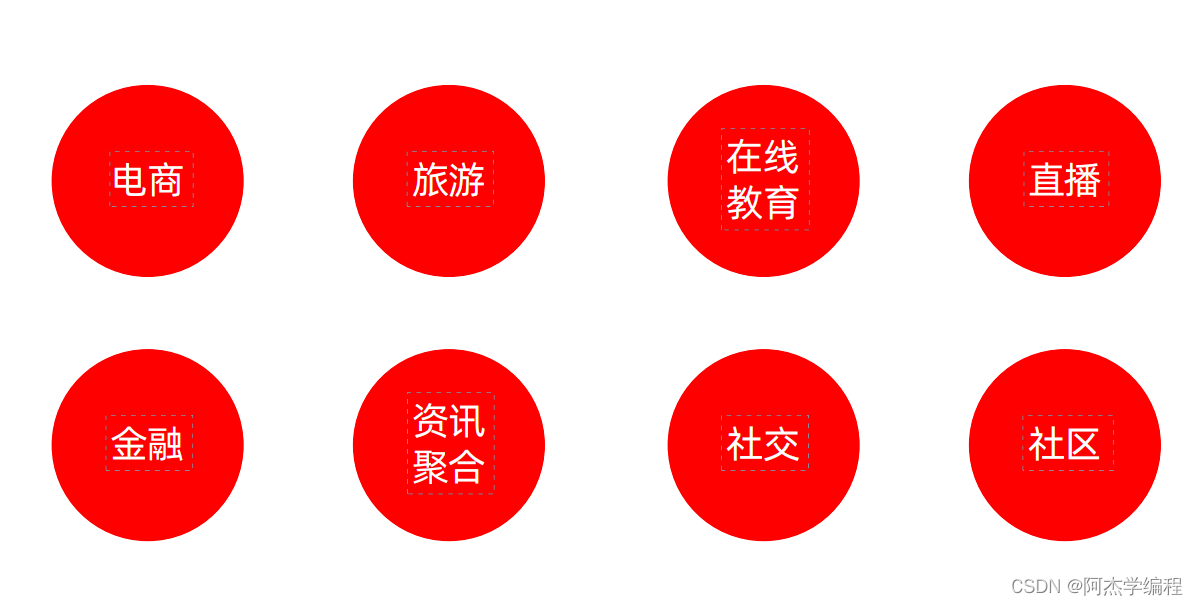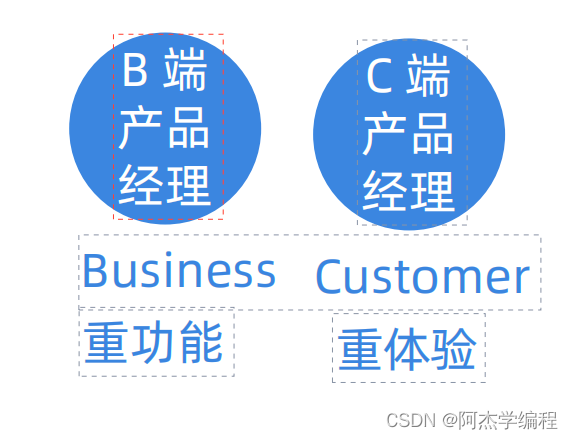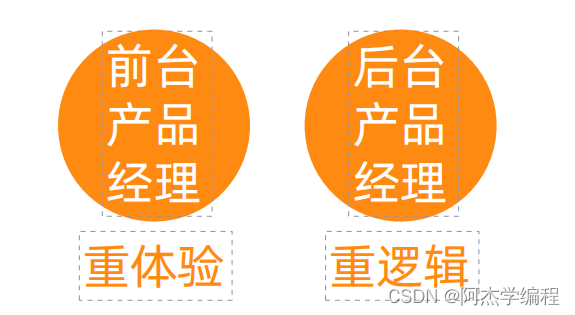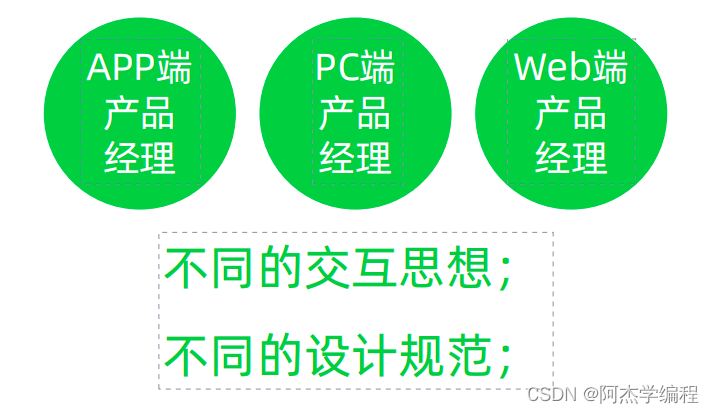Previous article: 2. Job content of product managers_Ajie’s blog for learning programming-CSDN blog
1. Classification of product managers
We divide product managers into two major types, one is from the traditional industry and the other is from the Internet industry. Just understand this briefly.

You will find that most of them are physical labor, such as product managers, development, UI, etc.
Let’s put it bluntly. In fact, it is still physical work, mainly physical work. Of course, you also have to use your brain. After using your brain, you start physical work.
But most of us carry out our work in front of computers. You can look at the differences between them. Traditional industries generally produce some products, which are specific products and tangible products.
A pure Internet company does not produce tangible products. He may only make products that are intangible services like WeChat and Baidu. But Internet companies will have tangible products, such as Alibaba. Alibaba’s products include Taobao, Tmall, Xianyu and other intangible service products. Does it have tangible products of its own? have.
For example, has Jack Ma ever invested in an unmanned supermarket? So we need to know that Internet companies can help traditional companies promote other products. This is one of their differences.
2. Common Internet industries

3. Common Internet product examples

Seeing that there are such Internet products, here is a requirement. What is it? That is, everyone should experience more products in daily life, especially some national-level products, phenomenal products, and star products.
What is a national-level product? The national-level product is very simple, two WeChat and one Douyin: WeChat, Weibo, and Douyin. The most classic ones, including almost all the ones in the picture above, are national-level products.
Some people may not like Pinduoduo. Please note that if you don’t like Pinduoduo before you learn to be a product manager, or before you become a product manager, there is no problem if you don’t use it.
But once you embark on the road of product manager, if you don’t like Pinduoduo, you don’t like Didi, you don’t like Xunlei, it doesn’t matter, but you have to use it.
Do you understand? You have to use it, and you have to know why Pinduoduo is so popular and what are the highlights of its products. This is the most basic quality of being a product manager.
So what is a phenomenal product? This product was very popular for a period of time, but after a while, it disappeared. For example, there was a very popular mini program game, "Sheep". This little game is a phenomenal product. Why? It has been popular for a while but then stopped. What’s the reason? We have to analyze it. At that time, this game was designed with two levels. The first level was for beginners, and the second level was equivalent to not being allowed to pass, which caused players to challenge themselves and have cognitive dissonance, and wanted to prove their ability. IQ and luck.
There may be reasons for the later failure, including but not limited to.
Later, many people began to modify the game data. If you don't let me pass, then I will brush it. Then there are the problems of many advertisements, game plagiarism, and freshness, etc.
There are also star products. You can go to some application markets, that is, your app store. In the app store, you can see some social and financial products, for example, and look at the rankings. You can download the top ten products in the rankings. Come down and experience it.
This is a quality that a product manager must possess, that is, you must be very diligent in experiencing various products.
4. Classification of product managers
Next, let’s talk about the classification of product managers.
The first category is what kind of industry we have, what kind of product manager we have.

Just understand this.
5. Classification of product managers
The following are what everyone needs to master. Let’s look at the first category:

5.1 The first classification method: B-side and C-side
We divide products into B-side product managers and C-side product managers.
First of all, what is the B-side.
B refers to Business, which is a product of To B, a B-side product.
for example:
The DingTalk and Enterprise WeChat we see are all B-side products. B-side products mean that after I develop this product, it is actually for enterprises to use.
To B's products are for enterprises. B-end products focus on functions. Function-oriented refers to the fact that this is a To B product for enterprises to use. Who is the enterprise? The enterprise is Party A, we are Party B, and Party A is the father. Whatever Party A asks us to do, we will do it. Therefore, it is function-oriented, that is, we will do whatever it asks us to do. This is a to B product. Therefore, B-side product managers focus on functionality.
C refers to Customer. For products like To C, like WeChat, it is for individuals. What does it mean?
For this kind of personal product, your users are thousands of individuals, and the needs of users may be different. What does he value? experience.
for example:
If the experience on Taobao and Tmall is not good, what can we do? We can immediately replace our shopping products with JD.com and Pinduoduo.
What does that mean?
That is, the product experience on the C-side must be good. If not, you will lose customers, which is very serious!
This is the first classification, B-side and C-side.
5.2 The second classification method: front desk and back desk

We must remember: the front desk focuses on experience, and the back desk focuses on logic.
First, let’s understand what is a front desk?
The front desk is very simple. WeChat, Taobao, and Tmall that everyone uses every day are the products that users use, which are front desk products.
This product is intended for a specific user.
Then the background:
The backend is for internal use of the company.
The front desk is for users, and the back desk is for internal staff of the enterprise.
After talking about this difference, you may understand why the front desk emphasizes experience and the backend emphasizes logic.
The front desk emphasizes experience. As we just said, if you use it for users if you have a bad experience, then sorry, users will just stop using it.
What does it mean to emphasize logic in the background? The backend is for internal use of the company and is a little rough. It doesn't matter, we can just make it for him whatever function he wants to do.
The interface experience is a little bit worse, but that’s okay. Then people will complain a little bit, because the internal system won’t work if you don’t use it.
for example:
The company's OA (office automation system), financial reporting in OA is really troublesome. It really doesn't work.
But there is no way. You are an internal employee of the company, don’t you use it? If you don't use it, it means you have resigned.
So what matters in the background is logic, so you should pay attention to this.
You may ask this question, what is the difference between the C-end focusing on experience and the front-end also focusing on experience?
It should be noted that these are just different ways of dividing product managers.
It is equivalent to two planes. You should not forcefully compare the straight lines on the two planes.
5.3 The third classification method: APP, PC and Web
What's the difference between them? They are different interaction ideas and different design specifications.

How do you understand this? The APP side is the various APPs used on everyone’s mobile phones.
The PC client is the client on your computer.
The web side is actually some web-type products.
The difference between them is different interaction ideas and different design specifications. What does this mean?
5.3.1 Interaction thinking
What is APP-side interaction? is a linear interaction.
What is linear interaction?
Just like when I open a page, how do I open it from the first page to the fourth page?
You have to open the first page first, then the second, the third, and finally the fourth page.
The same goes for returning to the first page.
(1 → 2 → 3 → 4,4 → 3 → 2 → 1);
This is called linear interaction.
The counterpart of linear interaction is nonlinear interaction. Both the PC side and the WEB side are non-linear interactions. What does that mean? That is, I open the first page, the second, the third, and the fourth page.
I can go back to the second, first or third page at once.
This is called different interactive ideas.
5.3.2 Different design specifications
What do different design specifications mean?

If you look at the APP side, the mobile phone is so small, the PC is a screen, and the WEB side is also a screen. The things on each page are different, so they have different design specifications.